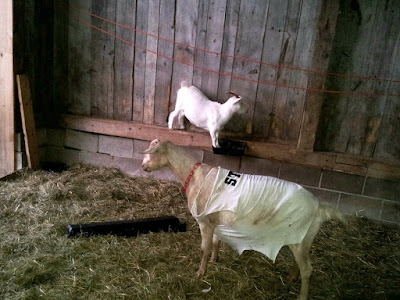 |
| Piper checking out her new digs shortly after arriving at Alewive Pond Farm in 2012 |
Piper, and her long-time friend, Simone were the first two goats at our farm. Several years ago, Piper, was bred and had three stillborn kids. We placed the kids in the hay beside her and she licked and nudged their still bodies, encouraging them to come to life. As time passed and none of them moved she became concerned, looked at us, returned to the kids, and made encouraging sounds.
At the same time we had a young doe who had just given birth to two kids and had no interest or understanding of how to care for them, which we learned, sometimes happens. She was unwilling to stand still for them to nurse, wandered away from them, did not clean them or nuzzle them, and showed no signs of bonding. We were concerned we would have to bottle feed and care for these kids ourselves.
I suggested we put these kids in with Piper who seemed distraught when we removed the lifeless kids from her stall. We carried the kids ignored by the young goat ro Piper's stall and laid them gently in the hay. Piper immediately went to the kids and began licking them, nuzzling them, and encouraging them to stand and nurse. With her encouragement, the kids began to nurse and immediately bonded. At one point, Bev remembers, Piper came over to her, as she watched from the door, and began licking her hand, as if to say, "Thanks."
Piper was so attentive as these kids developed. The doeling, Fanny remained a part of our herd, and she and Piper were always close, often eating together and sleeping next to each other in the stall. Piper watched out for Fanny, even as an adult goat, whether they were in the barn or out in the pasture.
 |
| Piper with her daughter Fanny grazing several weeks before her death this summer |
As one of the larger Alpine goats in our herd, Piper was “2nd in Command,” for most of her life in the herd to the herd queen, Simone. Both goats came from farmers Joel and Ann, who made goat cheese to sell at the local farmer's market. Both were only a year or two when we first saw them at their farm. When we first walked into their barn, Piper greeted us by lopping one of her front legs over the top fence, as if to shake our hands.
Saying goodbye to both goats in the past year signaled a change in both the herd, and where we are with our goat adventure. Six goats remain, all smaller goats. Two of the goats, a brother and sister, Manly and Half-Pint we acquired shortly after they were weaned, within weeks of getting Simone and Piper. They have spent their whole lives at Alewive Pond Farm, and are affectionately called the Bunions, for their ability to keep us on our toes. . The remaining four goats came from other farms over the years.
Looking through the pictures over the years to find these of Piper, was like looking through the history of the farm and brought back some wonderful moments with the goats we’ve had and some of the different, often funny, silly, or contemplative moments.
 |
| Always curious, Piper kept an inquisitive eye on all the barn happenings |
Well Piper, when you catch up with Simone, say hello from all of us on the farm! You’ve been a wonderful friend, a great mother, and we will dearly miss you on the farm!




